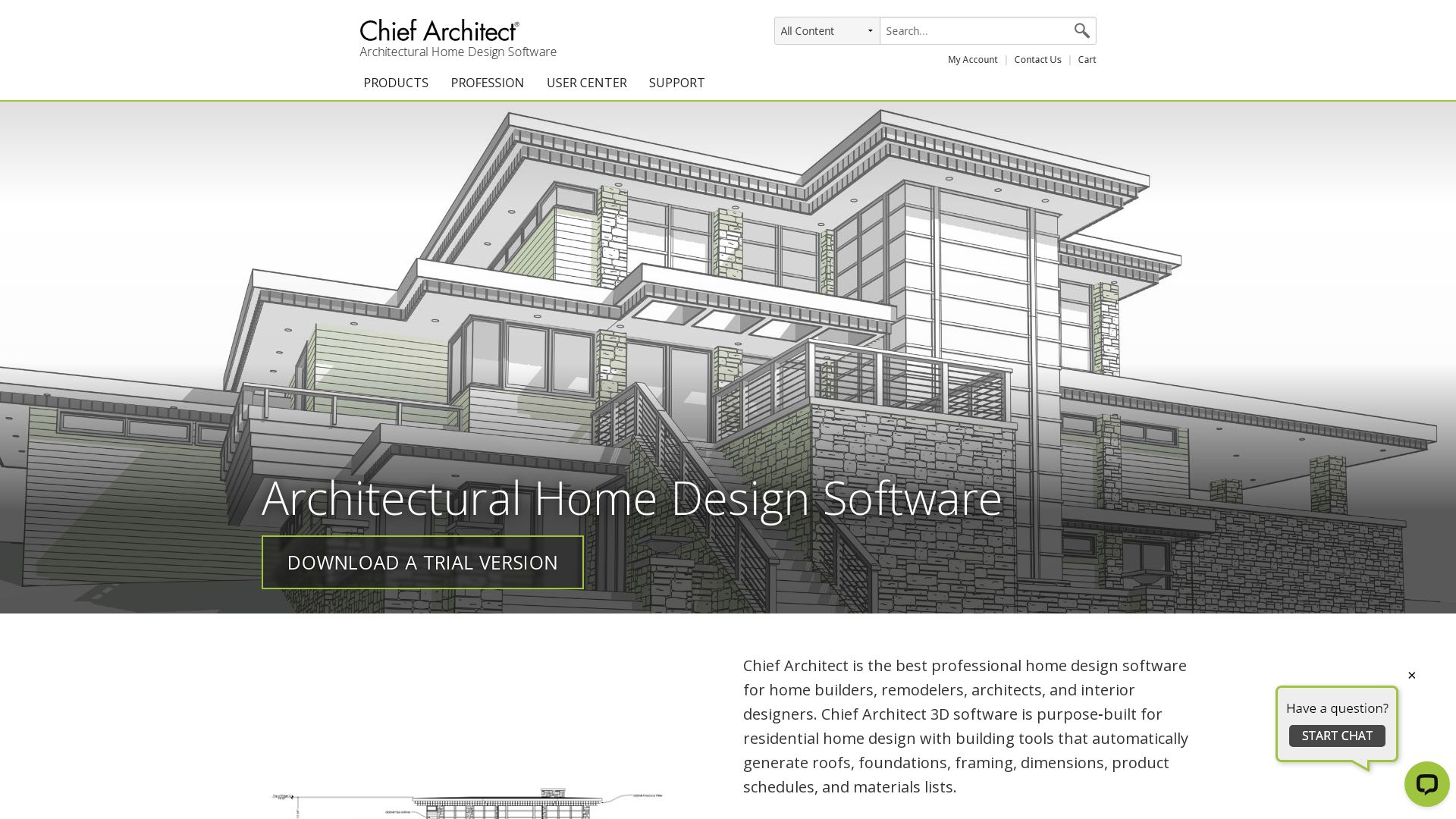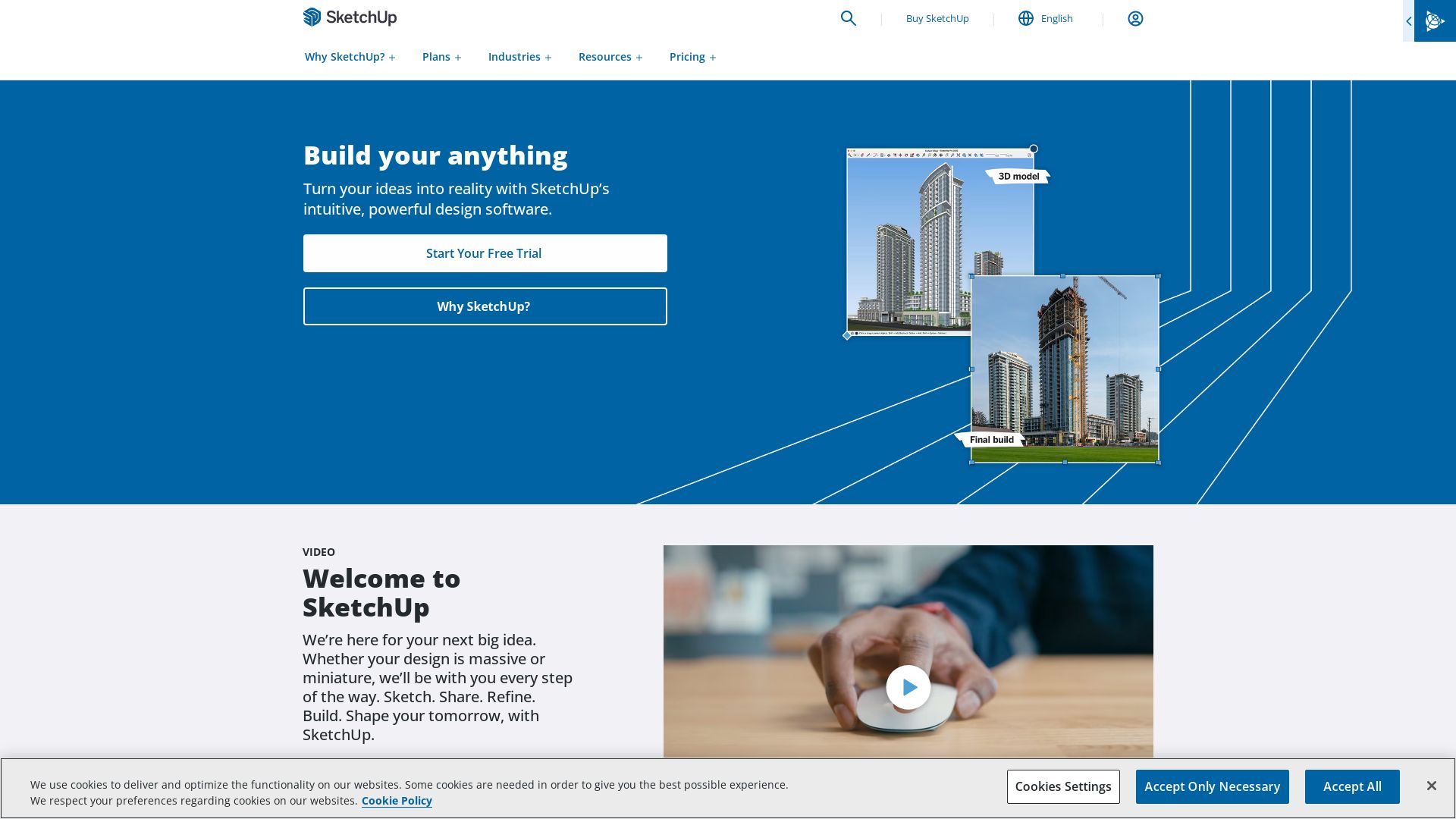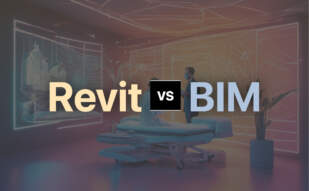BIM is a pivotal process revolutionizing construction through collaborative 3D modeling and information management. Architects, engineers, contractors benefit from this efficient planning tool.

Looking for alternatives to BIM? Consider Revit, ArchiCAD, AutoCAD, Tekla, Chief Architect, SketchUp, CAD, 3ds Max, Rhino.
Revit
Brought into existence by Autodesk and steeped in rich history, Revit has become a frontrunner in the field of CAD building information modeling. Initially released on April 5, 2000, it was designed as an all-in-one solution for architects, designers, engineers, & contractors. With roots traced back to Charles River Software in 1997, Revit was named after the corporation in 2000 before getting acquired by Autodesk in 2002.
Revit Top Features
- Enables you to design components in 3D, supplemented with 2D draft elements for model annotation.
- Pioneering in offering 4D building information modeling with a unique capability, tracking various lifecycle stages of a building.
- Distinguishes itself by offering parametric modeling intricately designed for the construction sector.
- Equipped with Collaboration and Coordination tools for multidisciplinary teams.
- Features Energy Analysis tools for sustainable design.
- Enables Construction documentation generation that shortens common workflows.
| Compatibility | Interoperable with other Autodesk software and can be used in tandem with VR settings for real-time team collaboration. |
| Remote Work Option | Acknowledging the global shift towards remote work, Revit’s cloud-based access allows anywhere, anytime functionality, and automatic waterfall updates. |
| Investors | Backed by Atlus Venture and North Bridge Venture partners in their early development stage. |
Revit Downsides
- Being a highly specialized software, Revit requires a steep learning curve and substantial training.
- Coming from a paid model, it can be cost-prohibitive for freelancers or small-scale firms.
Revit Pricing
Autodesk Revit is available through a subscription model. Prices vary between $25 and $120 a month. For those seeking a competitive price, the Autodesk AEC Collection offers Revit at a reduced cost under its monthly subscription.
Revit Use Cases
Use case 1: Architects & Designers
Architects and designers make extensive use of Revit’s potent 3D modeling and 2D drafting features. It provides an integrated platform for 3D modeling workflow and easy documentation of architectural systems.
Use case 2: Engineers within MEP systems
Engineers within Mechanical, Electrical, and Plumbing (MEP) systems find utility in Revit’s parametric modeling and 4D building information modeling. It aids in tracking different lifecycle stages of a building, enhancing project efficiency.
Use case 3: Contractors
Revit’s ability to facilitate collaboration with multi-disciplinary teams and generate construction documentation expedites workflows, proving advantageous for contractors managing building projects.
ArchiCAD

ArchiCAD, developed by Hungarian firm Graphisoft, is a leading BIM CAD software that caters to both aesthetic and engineering elements in the design process of built environments.
ArchiCAD Top Features
- Interoperability: Direct API links to 4D, 5D software and third-party Add-On developers.
- Cross-compatibility: Can import/export DWG, DXF, IFC, BCF files and more.
- BIM functions: Complete design suite with 2D and 3D drafting, visualization, etc for architects, designers, planners.
- Remote collaboration: Unique file exchange solution and a Graphisoft BIM Server for worldwide project coordination.
| BIM to AR: | Export designs to BIMx format for viewing on desktop or mobile AR platforms. |
| Parametric objects: | Data-enhanced parametric objects allow users to virtually build and visualize constructions with structural elements. |
| Open BIM: | ArchiCAD is credited as one of the founders of the Open BIM concept. |
ArchiCAD Disadvantages
- Pricing uncertainty: Pricing structure can vary based on the plan, number of licenses, and existing ArchiCAD versions used.
- Usability: A steep learning curve could be anticipated, especially for individuals new to BIM software.
ArchiCAD Pricing
ArchiCAD’s pricing fluctuates based on the purchased plan, the number of licenses, and the current version of ArchiCAD in use. A 30-day fully functional trial version is likewise available.
ArchiCAD Use Cases
Use case 1: Architects and Designers
ArchiCAD’s rich features allow architects and designers to create detailed, aesthetically pleasing models. The data-enhanced parametric objects makes it user-friendly for in-depth simulations.
Use case 2: Construction planners
Construction planners can drag-and-drop structural elements into the ‘virtual building’ to analyze various design outputs.
Use case 3: BIM Curriculum Developement
For educators weaving BIM into their curriculum, the provision of an educational license type by ArchiCAD is a huge plus.
AutoCAD
AutoCAD, the brainchild of Autodesk, changed the course of computer-aided design when it hit the market in 1982. It swiftly became the most prominent 2D and 3D design and drafting tool.
AutoCAD Top Features
- Conceptualization and Design production: AutoCAD enables you to visualize an idea and create designs with technical precision.
- API-supported customization and automation on new feature additions.
- Creation of vertical products like AutoCAD Architecture, AutoCAD Electrical, and AutoCAD Civil 3D.
- Drawing and version history feature to track the evolution of the design.
| Employs Rapid Design Calculations | Supports Wide Range of File Formats |
| Mass Adoption | 3D Animation Software for High-quality Content |
| Suitable for Wide Range of Industries | Integrates with Other Applications Like 3D Max |
AutoCAD Limitations
- Can be considered expensive when compared to other software solutions since the introduction of subscription pricing in August 2016.
- Requires a steep learning curve due to complexity of functions and commands.
AutoCAD Pricing
AutoCAD transitioned from perpetual licenses to subscription pricing in 2016. Price details should be checked on their official website.
AutoCAD Use Cases
Use Case 1: Construction Industry
AutoCAD, when used in conjunction with Autodesk Building Design Suite, provides an effective combination of BIM and CAD tools. Its key contribution was during the construction of the Shanghai Tower to capture the twisted structure and ensure environmentally friendly construction.
Use Case 2: Entertainment Industry
AutoCAD’s 3D animation software is used in the entertainment industry to produce high-quality content.
Use Case 3: Aerospace, Aviation, Automotive, and Other Industries
AutoCAD’s versatility shines in various sectors, including aerospace, aviation, automotive, fashion, medical devices, and oil and gas. It supports a range of file formats, including those preferred by most 3D printers.
Tekla

In the constellation of Building Information Modeling, Tekla burns bright as a beacon of structural design optimization, a marvelous convergence of analysis, design, and BIM all locked in a graceful dance. Regarded for its distinguished one interface, one model philosophy, Tekla offers an environment conducive to collaboration among architects, fabricators, and contractors, weaving all into a harmonious whole.
Tekla Noteworthy Features
- A thorough marriage of physical modeling and accurate simulations for efficient design.
- Unparalleled gravity and lateral system design.
- Auto-generation of wind loadings and an advanced Finite Element (FE) engine for tackling complex tasks and structures.
- Transparent analysis results that facilitate debugging and design optimization.
- Automated design of all steelwork, reinforcement for beams, columns, slabs, walls, and more.
| Product | Notable Aspects |
|---|---|
| Tekla Structural Designer | This product shines with its ability to optimize buildings in less time. Any complexity or size, be it a high-rise or an industrial complex, bows to its might. |
| Tekla Structures | This versatile offering can model structures using different materials including steel, concrete, timber, and glass. Whether it is high-end residential buildings, bridges or skyscrapers, this software breathes life into ideas. It boasts of an IFC compliance ensuring smooth interoperability. |
Tekla Potential Hurdles
- While robust, the software may require skilled resources to leverage its full potential.
- The one interface approach, while integrated, might present an initial steep learning curve for new users.
Tekla Use Cases
Large-Scale Construction
Architects and engineers embarking on large-scale construction projects will find in Tekla Structures a faithful ally. The product’s ability to handle large models with diverse materials assists in the creation of complex structures like stadiums or offshore structures.
Residential Projects
Residential construction stands to gain from its sophistication and attention to minute details, which ensures precision and efficiency in design implementation.
Infrastructure Development
Infrastructure development projects can leverage Tekla Structural Designer for efficient design of large-scale structures like bridges and roadways, acknowledging its efficiency and overall optimization capabilities.
Chief Architect

Emerging from the picturesque town of Coeur d’Alene, Idaho, Chief Architect has been revolutionizing the field of 3D architectural design since 1992. Born out of the frustration of hand-drawing architectural plans, this software specializes in efficient and precise drafting, cost estimating, and project management.
Chief Architect Top Features
- 3D Rendering: Transform your 2D blueprints into interactive 3D walkthroughs.
- Material Lists: Accurately calculate building materials to cut down on waste and save cost.
- Project Management Tools: Keep track of your project timelines and optimize workflows.
- Integration Capabilities: Seamlessly integrates with AutoCAD, Sketchup, and Google Earth.
| Supported platforms | Customer Support | Security Measures |
|---|---|---|
| Windows, macOS, iOS, Android | Online and phone support, tutorials, video guides | robust data policy, stringent access controls, and encryption |
Chief Architect Limitations
- Some users suggest improvements for advanced features.
- Perpetual license model might be pricey for small projects or startups.
Chief Architect Pricing
Chief Architect operates on a perpetual license model that involves a one-time payment. Monthly subscriptions are also available for those seeking more flexibility.
Chief Architect Use Cases
Use case 1
For home builders and interior designers, Chief Architect allows for precise cost estimating, efficient project management, and the creation of visually stunning 3D architectural models.
Use case 2
Small to medium-sized businesses in the building industry can benefit from Chief Architect’s scalability and variety of deployment options (cloud, on-premise, hybrid).
Use case 3
For academic institutions offering architecture courses, Chief Architect can offer a robust and accessible platform for teaching and mastering architectural design principles.
SketchUp

Welcome to the world of SketchUp: the potent tool in the realms of CAD. All about 3D modeling, this maverick innovation takes you through the landscapes of architecture, design, and even game development. Developed by Trimble Inc., SketchUp has been reshaping modeling spaces since the early 2000s.
SketchUp Top Features
- Smart Drawing Tools: SketchUp leads with intuitive and highly user-friendly tools, making it a go-to for both rookies and pros.
- Real-time Collaboration: Make real-time team work a reality with SketchUp’s robust collaborative features.
- Impressive Rendering Options and Compatibility: With SketchUp, photorealistic renders come to life with V-Ray support, and options for different rendering styles.
- Massive 3D Warehouse: This mammoth warehouse allows 3D model sharing, download, and upload.
| Feature | Description |
|---|---|
| Extension and Plugin Support | Featuring a powerful array, SketchUp comes with third-party additions |
| Push/Pull Technology | This patented feature is a worth-considering USP |
SketchUp Drawbacks
- Extension Limitation: One downside is that extensions are not supported in the web-based SketchUp Free version.
- Format Support: While supporting a variety of 3D modeling formats, PDF is available only for Mac users.
SketchUp Pricing
About SketchUp’s pricing: The ball game has shifted to a subscription model since November 4, 2020. However, SketchUp Free, a web-based app, is at your service, but with limited functionalities.
SketchUp Use Cases
Use Case 1: Architecture
In the canvas of architecture, SketchUp’s intuitive interface, smart drawing tools, and wide range of extensions give it a noticeable edge. The impressive rendering options bring architectural models to life with photorealism.
Use Case 2: Engineering
For engineers, the precision of SketchUp’s design tools and compatibility with advanced 3D modeling formats make it an effective and flexible tool.
Use Case 3: Game Development
SketchUp steps into the gaming arena, offering a conducive environment for video game development. With its massive 3D warehouse, game developers get access to a plethora of resources that can be customized to fit their needs.
CAD
Born in the ever-evolving renaissance of technology, CAD (Computer-Aided Design) is an eminent player in the 2D and 3D design creation realm. Its conceptual roots date back to the late ‘50s, with flourishing advancements through the ‘60s and ‘70s, making it a trusted tool in sectors such as the automotive and aerospace industries.
CAD Top Features
- 3D Modeling: Pioneering 3D abilities since 1982, solidifying its dominance with the introduction of the 3D modelling feature in 1985.
- Extensive Utility: Leveraged by architects, graphic designers, manufacturers, engineers, game and product designers, solidifying its universality across domains.
- Enhanced Workflow: Promises lower design production costs, increased productivity, improved design features, and streamlined workflow.
| Software Evolution | Significance |
|---|---|
| AutoCAD launch, 1982 | Transformed the CAD landscape, cementing Autodesk’s robust influence. |
| CATIA, 1977 | Introduced engineers to 3D modeling, transforming perception of feasible design capabilities. |
| PRO/Engineer, 1987 | Brought Sketchpad’s interactive features to CAD, changing constraints understanding. |
CAD Limitations
- Limited Backwards Compatibility: Constantly updated with industry developments, CAD software may face compatibility issues with older versions.
- Necessity of Training: For new users, grasping CAD’s extensive features could be challenging, necessitating appropriate training.
CAD Use Cases
Use Case 1: Aerospace Industry
Historically valued in aerospace, CAD capitalized on intricate design requirements, facilitating robust, detailed projections of complex machinery.
Use Case 2: Automotive Industry
In the automotive sector, CAD enables precise iterations for evolving vehicle design, expediting development cycles.
Use Case 3: Architectural Realm
In the architectural domain, CAD strengthens design conceptualization, streamlining project execution with detailed, accurate blueprints.
3ds Max
In the world of 3D graphics and modeling, Autodesk 3ds Max stands as a potent alternative. Renowned for its intricate details and precision, it’s extensively utilized for creating 3D animations, models, graphics for games, as well as images.
3ds Max Top Features
- Modeling capabilities: 3ds Max offers paramount advanced modeling capabilities, enhancing the user experience exponentially.
- AutrDesk Vault: The software is integrated with a centralized location for managing 3ds Max assets.
- Scene Explorer: A feature providing a hierarchical view of scene data, boosting the navigation and organization process.
- Animation tools: The comprehensive repertoire includes expressions, scripts, list controllers, wiring and more.
- Advanced texturing: With options for creative texturing and planar mapping, 3ds Max takes model detailing to the next level.
| Feature | Description |
|---|---|
| MAXScript | A built-in scripting language that provides users with extended customization options. |
| Specialized plugins | A wide array of plugins can be purchased separately to push the boundaries of 3ds Max capabilities. |
| Next-Gen compatibility | Its highest compatibility lays within Windows 10 and Windows 11 offering a smooth user experience. |
3ds Max Limitations
- Primarily limited to Windows platform thus restricting accessibility for non-Windows users.
- Learning curve can be steep, especially for beginners.
- May require significant system resources for complex tasks.
3ds Max Pricing
Pricing for 3ds Max is on a token-based system; users pay as they go. Additionally, specialized plugins are available for purchase separately, further expanding the software’s capabilities.
3ds Max Use Cases
Use case 1 – Video Game Development
Thanks to its robust suite of tools and plugins, 3ds Max is widely used in the video game industry for character and environment modeling, animation, and more.
Use case 2 – Architectural Presentations
For architects and design firms, 3ds Max provides an effective platform to create detailed, photorealistic models of building designs for presentations to clients.
Use case 3 – Educational Programs
The software is also integrated into educational programs across secondary and tertiary level institutes for teaching 3D modeling and animation, allowing students to gain practical, hands-on experience with industry-standard software.
Rhino

Envision a world beautifully crafted with numerical precision, intricacy interlinked with unfettered imagination – that’s the realm of Rhino. This 3D modeling software, designed by Robert McNeel & Associates, is a paladin in fields ranging from architecture to automotive design, and from jewelry creation to industrial design, adding a touch of artistic precision to stringent scientific principles.
Top Features of Rhino
- Adept at creating organic shapes, harnessing the power of algorithms and add-ons present in its latest version, Rhino 7.
- Exemplifies compatibility, with utilization alongside design, drafting, CAM, prototyping, rendering and illustration programs.
- Offers a a unique tool, Rhino.Inside.Revit, a bridge linking Rhino and Grasshopper with the Autodesk Revit environment. This grandly supports architects and designers creating intricate structures.
- Crafted to double up as a conversion tool, Rhino helps users overcome incompatibility issues between other software packages.
- Built to support scripts of two languages, namely Rhinoscript (based on VBScript) and Python, thus broadening its users’ sphere of command.
| Additional Features | Explanation |
|---|---|
| OpenNURBS Initiative toolkit | Allows users to exchange file format (.3DM) with other programs. |
| Supports 30+ CAD File Formats | Enables importing and exporting in multiple formats, easing integration with existing workflows. |
| Freeform Surface Modeler | Uses NURBS mathematical model to create high-level 3D geometries and complex surfaces with unparelled freedom and precision. |
Rhino Downsides
- Although widely compatible, Rhino is not specifically intended for 3D printing; may require pre-printing optimization.
- For students and teachers, the cost might be an impediment, with upgrade pricing standing at €95.
Rhino Pricing
For the precision it promises, Rhino’s license pricing is set at €995 for both Windows and Mac. For upgrades from previous versions, the price is set at €595. For the scholars charting paths in the field, the software is available at €195, and an upgrade for them is priced at €95.
Rhino Use Cases
Use case 1: Architecture
In the arena of architecture, Rhino’s precise curves and complex surfaces enable architects to mold and construct intricate, substantial designs effortlessly within a 2D or 3D environment.
Use case 2: Product Design
In the world of product design, the precision and mathematical accuracy of Rhino builds tangible, realistic product simulations. Models, visuals, and 2D drawings can be synthesized fluidly within a single document, simplifying design processes vastly.
Use case 3: Graphic Design and CAD Processes
Graphic designers and CAD professionals greatly benefit from Rhino’s multitude of plug-ins and file format compatibility, allowing smooth data transfer and a seamless creative process environment.
Logan Bellbrook
Content writer @ Aircada with a knack for nature & AR/VR/XR. Blogging the intersection of tech & terrain.





